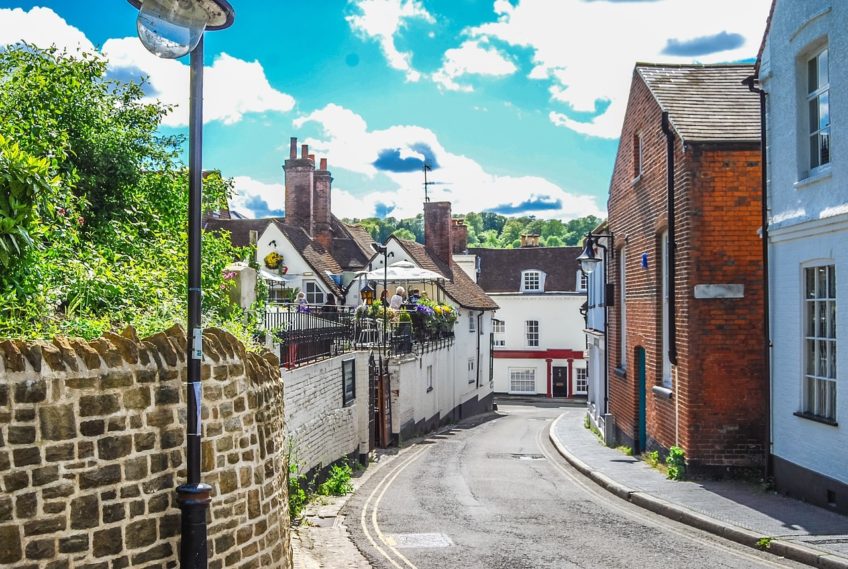Disclaimer: The following text contains many assertions and statements that I am not qualified to make. I have been driving in the USA for about 8 years, but only spent a little time studying the reasons why our road systems look the way they do. As a motorist in England, I have spent between 15-18 hours zooming around the countryside. The majority of my driving was in rural or semi-rural areas. These are my qualifications, such as they are!
Although our travels in England are far from over, part of the adventure is drawing to a close. For the past week, we have been based out of Durgan in Cornwall. This hamlet of maybe 8-10 cottages is far off the beaten track and I feel very lucky to have been able to experience its effortless serenity. As with most small towns, it is in the middle of nowhere on a lonely section of the coast. In England, being in the middle of nowhere means you must drive on the type of road that leads to nowhere. This has been an adventure.
To begin with, let me set the scene. In the past month, I have transitioned from a bike commuter, to the proud owner of a 2008 Honda Element, to one of two drivers in a 2,000+ mile road trip that did not involve much sleep, to the main driver in a country where people oddly drive on the wrong side of the road. It goes without saying that my reintroduction into the world of automobiles has been rapid. I know that I learned much in my two years of commuting on my Surly Long Haul Trucker, but I have probably learned far more in my last week of driving in England and I don’t just mean figuring out how to drive on the left side of the road.
With my Dad as navigator, I have driven through most of Cornwall, from coastal roads, to bustling cities, to desolate farm roads, to high speed ring roads. Each is wildly different and together they set a variety of challenges for unfamiliar drivers to overcome. Adjusting to the left side of the road did not take that long to get used to, while managing the differences between the English and American driving experience is still a work in progress. How different can they be? Let’s begin.
First of all, the English road network relies on a different infrastructure than their American counterpart. In America, we expect to see stop lights, lane lines, parking zones, divided highways, speed limits, regulatory signs, etc. These are all commonplace in the US. In England, roundabouts, single lane roads, minimal signage, and yielding replace many of the aforementioned American regulatory designs. They may not seem so different, but they completely transform the driving experience. Sometimes it feels like ordered chaos, but it is very clearly ordered, despite the lack of constant and overbearing government oversight. It just works. Roundabouts and single lane roads are simple, yet effective ways of controlling the speed of traffic and ensure that drivers are paying attention to the traffic around them.
The second layer that lends credibility to the English way of handling traffic is that there is an inherent level of trust in most of the traffic systems. Speed limits are not posted every mile, you are simply expected to drive comfortably with traffic. Roundabouts could be a disaster, but everyone trusts the surrounding drivers to act responsibly, knowing the consequences. On winding roads 10 feet wide with high hedges, there simply isn’t room for two cars. As a result, people drive slower, crawling around tight turns to make sure that no one else is coming. When two cars do meet, one backs up until they find an appropriately sized expanse where the two cars can pass. This is not done with anger or frustration, but often a smile and a small wave. It never feels like an imposition.
Everything I have mentioned so far is a departure from the wide-lane interstates and highways that Americans travel on every day. These roads are straight, hemmed in by trees, fast, and relatively anonymous. Gas is never that far away, and all the ammenities you need are located within a mile or two of the road. They are not particularly exciting or enjoyable. Convenience is essential when thinking about American roads and our habits as drivers. Our goal is to often to make the journey as effortless and efficient as possible, thinking only of our destination. In effect, this idea of travel and our infrastructure allow us to disengage from driving. The effortlessness of driving in America promotes motorists to do other things while driving, like texting, eating, etc. Indulging in these distractions is our decision, but our roads don’t necessarily discourage such behavior.
The biggest difference I have noticed while driving in England, as compared to America, is the way that it feels. I feel more engaged with the road, with the space that my Toyota Auris inhabits, with other drivers, with the countryside, etc. All of this has led me to realize that drivers in England expect something different from drivers in America. If you focus on your destination while you are driving down a one-lane country road at speed, you won’t react quickly enough to the oncoming car coming around a corner or you may not notice that you are drifting closer to the hedge that is buzzing by only inches from your left side mirror. If you are thinking only of the end of the road, you may not double check the traffic to your right as you enter into a busy roundabout. All of these seemingly trivial traffic keep drivers from relaxing and settling into their drive. In effect, they encourage drivers to focus on the present.



6 Responses
Kay Cahill
You might enjoy this piece by an American on preparing for the UK licensing test. He makes some of the same observations that you did. http://www.theguardian.com/commentisfree/2013/dec/02/uk-driving-law-versus-us
I am interested in what you say about roundabouts as a way of controlling and slowing traffic. There’s been a great interest in putting in roundabouts in Wisconsin (as anyone who drives to Mt. Horeb will have noted). The reasoning is that when roundabouts replace perpendicular intersections, the accidents that happen tend to be much less severe because cars collide at an angle rather than head-on or being T-boned. However, they decrease safety for bicycles and for pedestrians; part of the appeal of the roundabout is that cars never have to stop, and if traffic doesn’t stop, when do pedestrians cross? Are British roundabouts different from those in the US, or do they also imperil bicycles and pedestrians?
Simon
Interesting, and I think I agree with your ‘mindfulness’ thesis, though you seem to be comparing oranges and apples a bit. I suppose you’ll find similar conditions in all of England’s rural roads but Cornwall’s roads are particularly characterful, especially the narrowness, tall hedges and blind bends. The kind of car is a factor too; were you driving an automatic or a stick shift? Easy to ‘stab it and steer’ with the former but some attention needed with the latter. I’ve driven on interstates in the US with an automatic but most of my two years driving experience in the US was spent with a stick shift in Connecticut’s quiet corner (and some I-84 driving). I’m not a fan of the stop signs, and prefer Give Way signs and roundabouts, but the breadth of the roads (our motorways feel so narrow compared to your interstate highways, I’m relieved to say given the lane etiquette in the US!) and their straightness (we have some Roman ones of course), and their generally superior quality were what stood out for me as distinctive in CT. That and the fact that UK roads are relatively so much more congested (population densities different between New and Old England) and the beautiful forest scenery (which I immensely enjoyed reading about in your father’s Changes in the Landscape book) always made my drive times in the US a pleasure.
Jennifer Dueck
Thanks for the thoughts Jeremy. And on a more whimsical note check out “Do you speak Canadian” on Canadian road signs: http://www.bostonglobe.com/arts/2015/07/02/tycolumn/D39RVUckYXCyJRNTOd0sQP/story.html?event=event25
Marsha Hoem
Marsha Hoem here – one of your father’s former students. I enjoyed reading your piece on driving. Below is a link to a clip on driving in India that I used with my students to underscore my thoughts on verbal gridlock and the lost art of the segue… Note how there is no signage, but they aren’t running into each other because they anticipate – they are 360 degrees aware.
http://www.dailymotion.com/video/xhl7io_crazy-india-driving_fun
Safe travels!
Susan Fey
Totally agree that over-management leads to disengagement. It’s a big, radical theme that is visible in so many situations, cultures and environments. I remember a friend, visiting New Zealand for the first time, who was stunned that there were not caution signs along cliff edges and dangerous intersections. The expectation that you might need to take responsibility for your own safety is apparently a reasonable one in some places!
Amy Fitz
Interesting thoughts, Jeremy! We loved the similar traffic setup in Ireland. We found roundabouts much more convenient than stop lights, and were both intrigued and frightened by the teeny tiny country roads. We also quickly caught on to the practice of inching off the side of the road, still driving, while someone passes you on a “highway”. Though it did take Jon a few minutes to acclimate to a manual shift using his left hand! Happy travels!